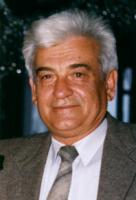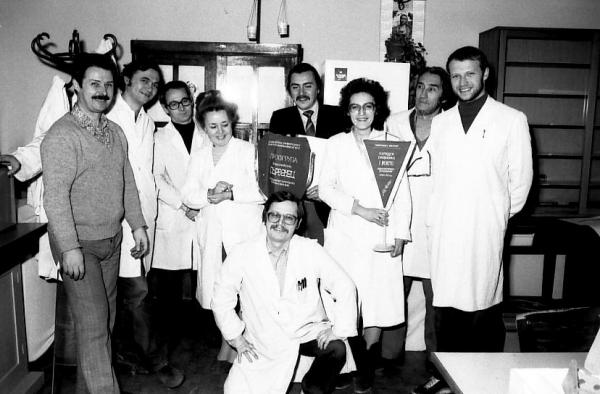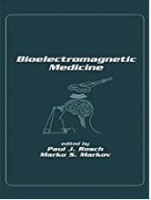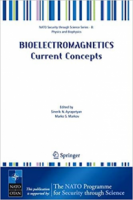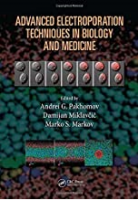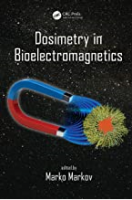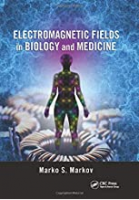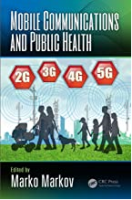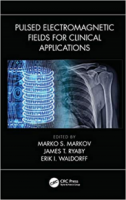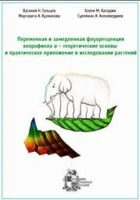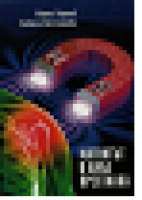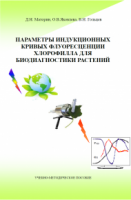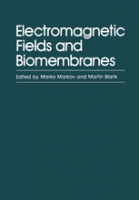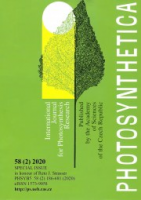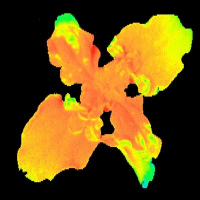Head of department: Assoc. Prof. Dr. Detelin Stefanov
Office: room 454
tel: (+359) 02 8167 389
e-mail: detelin@biofac.uni-sofia.bg
|
The beginning - Laboratory of Biophysics at the Department of Animal and Human Physiology. By decision of the Faculty Council of the Faculty of Biology in the academic year 1969/1970, a Laboratory of Biophysics was established at the Department of Animal and Human Physiology, headed by Prof. Lenko Kalchev (then Associate Professor). Assoc. Prof. Simo Todorov (at that time assistant) was appointed head of the laboratory. In the summer of 1969, two trainee assistants were selected - the biologist Maria Racheva and the physicist Marko Markov. The lectures are led by Simo Todorov, and Maria Racheva and Marko Markov prepare a workshop and lead the exercises in biophysics. |
Assoc. Prof. Simo Todorov, the first head of the department (1972-1988) |
| Separate Department of Biophysics and Radiobiology In 1972, the Laboratory of Biophysics, within the Department of Animal and Human Physiology, established an independent Department of Biophysics and Radiobiology. At that time, biophysicists were appointed to the department - Andrei Atanasov and two years later Assistant Professor Vasily Goltsev (both graduates of Moscow State University). Later, Research Associate Dimitar Chukniiski is also appointed. The department is joined by Research Associate Georgi Marinopolski, head of the isotope laboratory at the faculty. In collaboration with Research Associate Marinopolski also works as Assistant Professor Stamen Ivanov from the Department of Civil Defense, who joined the Department in 1992 as Assoc. Prof. after the closure of the Department of Civil Defense. From 1975 Assistant Professor Bozhidar Galutsov started working as radiobiologist in the department. Dragan Veselinov works in the department as a specialist in scientific equipment. The composition of the department in the 70s of the 20th century is a wonderful example of how to make a scientific composition of a department in such a multidisciplinary science as biophysics - three biologists (Simo Todorov, Maria Racheva, Bozhidar Galutsov), two physicists (Marko Markov and Dimitar Chukniiski), two biophysicists (Andrey Atanasov and Vaisiliy Goltsev) and a chemist (Georgi Marinoppolski). From 1978 the Faculty of Biology moved to the building built in 1928 for the needs of the Faculty of Agriculture on 8 Dragan Tsankov Blvd. At that time Emil Molle (later Associate Professor at University of forestry and technology) and Angel Yotkov worked in the department for different periods. In the 80s and 90s, graduates of the department itself entered the department - Virginia Dolchinkova, Valentina Ganeva, Margarita Kouzmanova. Later, in 1989, Maria Baldzhiyska, also a former graduate of the department, was appointed. The department is headed successively by Assoc. Prof. Simo Todorov (1972–1988), Prof. Marko Markov (1988–1990) and Prof. Vasiliy Goltsev (1990-2004, 2008–2012), Assoc. Prof. Bozhidar Galutsov (2004–2008), Assoc. Prof. Valentina Ganeva (2012 - 2020), and currently from Assoc. Prof. Detelin Stefanov. Representatives of the department have become over the years and part of the dean's leadership. Bozhidar Galutsov was elected dean (2004-2008), and before that for a short period before his departure for the USA the deputy dean was Prof. Marko Markov. Research is united in studying the influence of various physical and chemical factors on biological membranes. The first scientific direction in the newly created laboratory is the influence of magnetic fields on biological objects. The head Simo Todorov has published several articles on the influence of magnetic fields in co-authorship with Tsvetan Gemishev (later associate professor of Plant Physiology and with Alexander Goranov (later associate professor of Genetics)) Pioneering for Bulgaria studies of the action of permanent magnetic Fields on biological systems were conducted in the 1970s by Assoc. Prof. S. Todorov and Prof. M. Markov, and these studies were successfully continued by Dr. Margarita Kuzmanova. Aspects of magnetobiology are developed in cooperation with the Department of Medical physics at the Medical Academy (based on the joint research of Marko Markov with Prof. Nencho Todorov) and in the field of plant magnetobiology (Assoc. Prof. Tsvetan Gemishev from the Department of Plant Physiology and Research Associate Ivan Zafirov from the Institute of Plant Physiology, Bulgarian Academy of Sciences). The graduate of the University of Leipzig, Assoc. Prof. M. Racheva, started the research in the Department of Passive Electrical Properties of Cells - Bioimpedance and Surface Electric Charges. Her research on the binding of biologically active compounds - phytohemagglutinins and melittin with biological membranes of different origins, was successfully continued by Assoc. Prof. Virginia Dolchinkova. Systematic radiobiological research began in 1975 by B. Galutsov. S. Ivanov, M. Baldjiyska and M. Kouzmanova later became actively involved in them. A complex test has been developed for rapid assessment of radiation damage at the cellular, subcellular and membrane levels. Many natural and synthetic compounds with a protective effect have been tested. The protective effect of pre-irradiation with non-ionizing radiation in the millimeter range against damage from ionizing radiation is also shown. Biochemiluminescence is the subject of the work of Research Associate G. Marinopolski with using of home build device. Since 1980, a new successful field has been opened - photobiophysics. V. Goltsev's developments are aimed at studying the mechanisms of prompt and delayed chlorophyll fluorescence and the influence of various chemical and physical factors on the efficiency of electronic transport. In this area, too, a very successful cooperation has been developed with the University of Geneva, Switzerland, the Laboratory of Photobioenergetics, led by one of the most famous and leading scientists in the field of chlorophyll fluorescence, Prof. Reto Strasser. The works in the field of photosynthesis were continued by Detelin Stefanov, Kolyo Dankov and Momchil Paunov. |
|
|
| The staff of the department in 1986 (from left to right) Prof. Marko Markov, Assoc. Prof. Bozhidar Galutsov, Assoc. Prof. Stamen Ivanov, Assoc. Prof. Maria Racheva, Angel Yotkov, Assoc. Prof. Virginia Dolchinkova, Ch. Assistant Professor Georgi Marinopolski, graduate Ognyan Popov, and Prof. Vasiliy Goltsev (first row). All professors and associate professors at that time were assistants. |
Assoc. Prof. Andrey Atanasov conducts research on the conformation of proteins, as well as lipid-protein interactions in various biological membranes under the action of biologically active substances.
With kind help of Marko Markov in 1986, the department received the world's first commercial electroporator and thus began some of the world's first research on cellular electroporation. Detailed research on the effect of pulsed electric fields on cell transformation and the introduction of substances into yeast began in 1988 with the experiments of V. Ganeva and B. Galutsov. The laboratory, already under the leadership of Assoc. Prof. Ganeva, has won over the years many successful projects under the framework research programs of the European Union. As a result of long-term cooperation with Prof. J. Tessier from CNRS - Toulouse (France), a new flow method for electroinduced extraction of yeast proteins was developed. Assistant Professor Dr. Boyana Angelova later joined these studies.
Assoc. Prof. Virginia Dolchinkova has defended a PhD on the topic: "Photoinduced changes in light scattering from thylakoid membranes after chemical modification", supervisors: Assoc. Prof. Simo Todorov, Assoc. Prof. Vasiliy Goltsev - 1990. The main interests of Assoc. Prof. Dolchinkova include: Photoinduced changes in light scattering from thylakoid membranes and their surface characteristics in higher plants and algae; Electrokinetic and optical properties of biological membranes, etc.
Dr. Margarita Kouzmanova studies the biological effects of weak electromagnetic fields and the effects of mobile phones (GSM900) on biological objects.
Dr. Maria Baldjiyska is a graduate of the department, then works at the Institute of X-ray and Radiobiology at Medical University of Sofia, where he holds a doctorate with Prof. T. Panchev, and since 1989 is a member of the department as Assistant Professor and works in the field of medical radiology. Baldzhiyska has numerous publications, but mostly focuses on applied aspects with 35 rationalizations and inventions.
The current head of the Department of Biophysics and Radiobiology Assoc. Prof. Detelin Stefanov has completed his education in the Department of Biophysics and Radiobiology and after a doctorate on photosynthetic research at the Institute of Plant Physiology at BAS under the supervision of Prof. Ivan Yordanov. Further he received a postdoctoral fellowship at Prof. Ulrich Heber’s laboratory at Julius von Sachs Institute of University of Würzburg. He then spent two years postdoctoral fellowship in the laboratory of one of the leaders in plant ecophysiology, Prof. Ichiro Terashima, at the University of Osaka, Japan. Since 1991, Assoc. Prof. Stefanov (then PhD student) has been a part-time lecturer in the Department of Biophysics and Rabiobiology, and since 2011 he has been Associate Professor at the Department of Biophysics and radiobiology. Assoc. Prof. Stefanov works in the field of leaf photosynthesis research in vivo - fluorescence, photoacoustics, infrared gas analysis of leaf CO2 exchange, amperometric studies of O2 evolution, light absorption by leaves and delayed chlorophyll fluorescence.
Assistant Professor Kolyo Dankov defended his master's degree in the department, and then he was a doctoral student in the field of photosynthesis research at the Institute of Biophysics at the Bulgarian Academy of Sciences. After finishing his PhD, he returned to the Department of Biophysics and Radiobiology and continued his research in the field of photosynthesis, as well as he start teaching courses in neurobiophysics and molecular biophysics.
Until recently PhD students Boyana Angelova and Momchil Paunov are work in the field of electroporation of biomembranes (Assist. Prof. Angelova) and leaf fluorescence as a method for studying photosynthesis (Assist Prof. Paunov).
Long-term members of the department are the specialists Rumyana Terzieva, Elizabet Bantutova and Maria Gurmanova.
Most of the graduates and doctoral students in the department have worked in Bulgarian and European universities and institutes: Prof. Dr. Antoaneta Popova, Head of the Photoexcitable Membranes Section at the Institute of Biophysics and Biomedical Engineering, BAS, Prof. Dr. Yana Chekalarova head of Behavioral Neurobiology at Institute of Neurobiology, BAS), Assoc. Prof. Dr. Lyubomir Traykov Department of Medical Physics and Biophysics, Head of Biophysics Section, Medical University of Sofia; Senior Researcher Petar Lambrev, Head of the Photosynthetic Membrane Research Group at the Institute of Plant Biology Szeged, Hungary; Private Docent Ivelina Zaharieva from the Free University of Berlin in the group of biophysics and photosynthesis led by Prof. H. Dau.
In some of the world's leading research centers for photosynthetic research work: senior researcher Petko Chernev, research group on photosynthesis at the Department of Chemistry (Laboratory Angstrom) headed by Johannes Messinger, Maya Lambreva, working at the Institute of Crystallography, Monterotondo, Italy .
Currently, the department employs three habilitated lecturers, Assoc. Prof. Valentina Ganeva, Assoc. Prof. Virginia Dolchinkova and two Assist Prof. Margarita Kouzmanova and Koljo Dankov and Assistants Boyana Angelova and Momchil Paunov. Guest lecturers are Prof. Vasiliy Goltsev and Prof. Marko Markov.
RESEARCH ACTIVITY
Protocols for highly efficient electroinduced extraction of homologous intracellular yeast enzymes have been developed in a FP7 project. The applicability of the method for extraction of recombinant enzymes is also shown. A new FP7 project explores alternative high-performance approaches for the isolation of biologically active substances.
The mechanisms of the stress response of the photosynthetic apparatus under the influence of biotic and abiotic factors are studied. Biophysical approaches for plant phenotyping are being developed based on the analysis of the kinetics of chlorophyll fluorescence, delayed fluorescence and photoinduced light scattering at 820 nm. Artificial neural networks are being built and trained.
The leaf optical properties is studied by the light absorption. The mechanisms of prompt and delayed chlorophyll fluorescence; changes in the rate of photosynthesis as assessed by the rate of CO2 uptake and O2 evolution; photosynthesis in resurrected plants such as Haberlea rhodopensis is investigated. The use and development of non-invasive methods for evaluation of photosynthesis in intact leaves adapted to different environmental conditions.
The mechanisms of action of biological components, of their interaction with the environment through their interfacial surface are analyzed. The aim is to elucidate the molecular and signaling cascades between biophysical mechanisms in cells and the environment.
The biological effects of weak electromagnetic fields and their combined action with physical factors or chemicals are studied; the effects of mobile phones (GSM900) on biological samples are studied.
Published textbooks and monographs by lecturers from the department
|
|
|
|
| Bioelectromagnetic Medicine by Paul J. Rosch and Marko S. Markov | Apr 30, 2004 | Bioelectromagnetics Current Concepts: The Mechanisms of the Biological Effect of Extremely High Power Pulses (Nato Security through Science Series B:)by Sinerik N. Ayrapetyan and Marko S. Markov | Jan 12, 2006 | Advanced Electroporation Techniques in Biology and Medicine (Biological Effects Ofelectromagnetics) 1st edition by Pakhomov, Andrei G., Miklavcic, Damijan, Markov, Marko S. (2010) |
|
|
|
|
| Dosimetry in Bioelectromagnetics by Marko Markov | May 23, 2017 | Electromagnetic Fields in Biology and Medicine by Marko S. Markov | Jul 27, 2017 – преведена на китайски език | Mobile Communications and Public Health by Marko Markov | Jun 13, 2018 |
|
|
|
|
| Pulsed Electromagnetic Fields for Clinical Applications Hardcover – 24 Mar. 2020 | Переменная и замедленная флуоресценция хлорофилла а – теоретические основы и практическое приложение в исследовании растенийкнига Авторы: Гольцев В.Н., Каладжи Х.М., Кузманова М.А., Аллахвердиев С.И. Год издания: 2014 | Chlorophyll Fluorescence: Understanding Crop Performance — Basics and Applicationsby Mohamed H. Kalaji, Vasilij N. Goltsev, et al, 2017 |
| Popular science and practicums In 2016, Prof. Markov, in co-authorship with Dr. Lyubina Veselinova, published in Bulgarian THE MAGNET IN A WHITE APRON, which summarizes the achievements in Bulgaria and in Bulgaria on the application of magnetic therapy in clinical medicine. | ||
|
| ||
| In 2015, in co-authorship with Russian colleagues, Prof. Goltsev published a methodological manual for working with fluorimeters measuring induction curves. | ||
|
| ||
Organization of scientific events by the Department of Biophysics and Radiobiology and popularization of science
The scientific events organized by the department begin with the active participation and organization of Marko Markov, whose name is associated with several scientific conferences and schools organized worldwide. The beginning started with the First Scientific Conference of Students and Young Scientists "Man and the Biosphere" together with the Center for Environmental Protection at the Ministry of Ecology was organized in 1975. Later Marko Markov and the department staff held numerous scientific events and some of them gathered the world's elite in some areas of biophysics.
As a result of active cooperation between the department and the Medical University and in particular between Marko Markov and the founder of research in magnetic therapy in Bulgaria Prof. Nencho Todorov organized two important scientific events in the 80s of the 20th century. As a result of Marko Markov's active work in the field of magnetobiology, the President of the Bioelectrochemical Society Prof. Giulio Milazzo proposed to Marko Markov in 1984 to hold a scientific event in Bulgaria. In 1986 in the city of Pleven, Bulgaria was held the international school Electromagnetic fields and biomembranes with 30 lecturers from Europe and America. The lectures from this event were published by one of the most renowned publishing houses at that time, Plenum Press, edited by Prof. Martin Blanc and Marko Markov.
In 1989 a second school was held. Some of the most famous names in bioelectrochemistry, electro- and magnetobiology visit Bulgaria for this event - professors J. Milazzo, M. Blanc, R. Adey, E. Neumann, the president of BEMS then M. Swaycord and the future president S. Ueno, J. Tessier and many others.
Later in Bulgaria and abroad were organized many other scientific events with the active participation and leading role of representatives of the department. Prof. Goltsev is one of the organizers of a special issue of PHOTOSYNTHETICA journal dedicated to the world-leading scientist in the field of chlorophyll fluorescence Prof. Reto Strasser, with whom Prof. Goltsev maintains long-term scientific cooperation.
DOI: 10.32615/ps.2020.046 PHOTOSYNTHETICA 58 (SI), 2020
FOREWORD
Special issue in honour of Prof. Reto J. Strasser
HAZEM M. KALAJI AND VASILIJ GOLTSEV
Prof. Vasiliy Goltsev participates as an editor of a special issue of Frontiers in Plant Science dedicated to chlorophyll fluorescence:
Frontiers in Plant Science
Research Topic
Chlorophyll Fluorescence Measurements and Plant Stress Responses
Topic Editors: Marcin Rapacz; Hazem M. Kalaji; Vasilij Goltsev, Marian Brestic
